When selecting a tea for a mountain journey – and for every mountain journey there must be a tea – there is always a moment, a question: “which tea(s) for this particular trip?” The final selection signals not only a love for that particular tea, but it infers that I can live without all of the others that sit in chunks, cakes, and tight little nuggets within my treasure chests (which are simple cardboard boxes) here in Shangri-La.
In the haste and anticipation of an upcoming journey (which begins on Feb 15th), there is often a tendency to overlook items – even after years of mountain departures. Seldom, though, has there been a time when a tea hasn’t been selected with care and perhaps a bit of neurosis.
With most items that are packed for the mountains there is a well-honed system of ‘must haves’ which borders at times – to outsiders – as privation. Equipment, clothing and gear that ‘works’ (and has worked again and again) is unthinkingly rolled, coiled and folded into the rucksacks. Simplicity and precedent are two keywords in any of my selection decisions. Mountains are the perfect editors for those that observe its forces. Mountains and their almost schizophrenic sways between reckless beauty and stirring peril are the perfect (and unsympathetic) determiners of what can and does and what won’t work. They, in their severe and entrancing ways, demand that simplicity, respect and a good tea are taken into their corridors.
When selecting my little portable pleasures for a journey – and for me there is but one – there are always a few moments of almost neurotic deliberation on my part. That moment inevitably comes with the selection of a tea (and in some cases ‘teas’).
In the wonders of the above, of the heights – shale, scree, granite and white, there needs to be something that hits, that wakes, that inspires not only the taste buds but the entire body. This is where the selection becomes something almost clinical.
Within my boxes of ‘collected works’ there are old teas that are treats, there are potent, pungent blasts that pleasantly annihilate anything else upon the palate and there are those go-to teas that are simply good. What is needed is a pleasurable fuel.
For this particular expedition – a rare unsullied portion of mountain route that bends northwest from here in Shangrila (Gyalthang) along a long-unused portion of the Ancient Tea Horse Road – we will be on a course of perpetual ups and downs. We will travel through the hot valleys and up into snow passes to a point below the north-face of Kawa Karpo. Tea’s underrated ability to sate thirst will be as important for the trip as its abilities to stimulate and force the blood and – by extension – the rest of the mortal form into dynamic action.
A fermented Puer, black, smooth and good for empty stomachs and indeed any digestive track that is under duress will join for certain. Nothing ‘special’ is required, no aged teas needed here with qualities that are professed but not delivered. What is required is something well made where I know the producers, the pickers and the source…always these three ‘musts’ haunt my tea-world.
In this case a Bada Puer will do. Both Bada’s green unfermented form and its dark artificially fermented brethren have long been a kind of go-to tea for me. Naturally more mild than some other Puers, it can be revved up and intensified with increased steeping times or amounts of leaves to give the system a jolt.
This tea in its fermented dark form is less of a reviving tea than it is a calming and soothing tea with its bit of earthen nuttiness.
Amidst the various boxes of tea – every tea labeled in my fuddled scribbling with producer, date of harvest and exact harvesting locations – there are a few green unfermented teas that (for this trek at least) sing to me. I am looking for something that will shake the tongue with a kind of predictable power, something with some reckless energies. My eyes are looking for a very simple ‘Bang Po’ old town (there are two towns) – a small ‘un-exclusive’ village tea from the Nannuo area of southern Yunnan near Menghai. My recall of this tea is that it is inundated with raw power, simple virtues and a nice buzzy umph without stripping the tongue of its functions. Poking through I find the largely untouched remnants of the ‘Bang Po’ tea cake from early 2010 – my last pecking of it was about four months ago. It is lightly wrapped in a simple cloth-like white paper. No writing, none of the usual calligraphy or graffiti, no logos; nothing adorns the paper. It was purchased along with several others in the town from the growers and there is no need of elegant scripts on a good tea. Every family within the town picks from designated areas and to know the family is to know the region from where the tea comes.
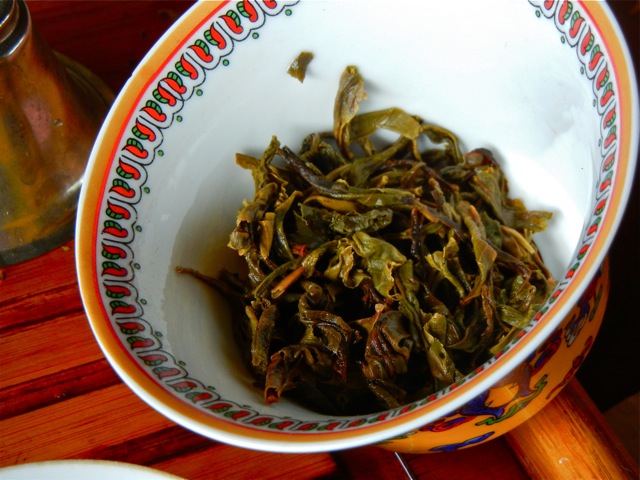
The Bang Po's leaves are whole, not chopped or cut...it is always more difficult to hide a bad tea when the leaves are entire and whole
I put it aside and continue to scan through the box of delights. Shifting some cakes to the side I uncover a yet to be touched 250 gram ‘tuo’ or nest/ball of unfermented Puer from the Dali-Xiaguan area. There are three such ‘tuo’s’ tucked away in here and all were purchased in 2004, which was the year of harvest. During a tasting with a friend who recommended I buy the tea, he commented that this tea would never lose its ‘force’. It was vegetal and powerful with a long lingering cut in the mouth. I pick it out of its wrapping and decide that it is time to do a ‘taste-off’ to see which of these two teas will be taken (the slightly ‘off’ part of me is set on the fantasy of taking both).
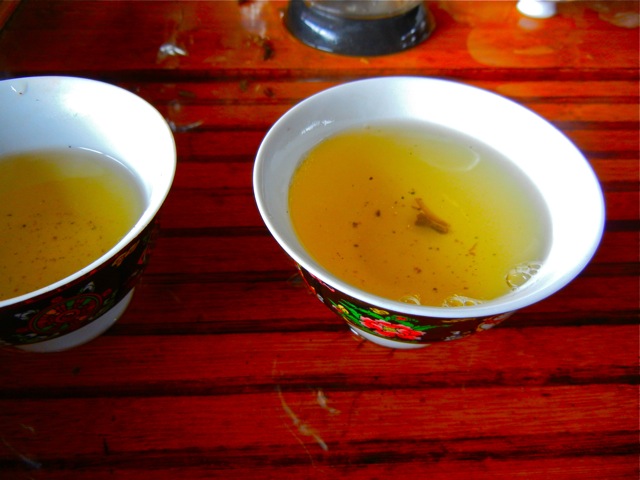
Even with a couple of errant leaf pieces at the bottom, the Bang Po's colour is true and clear and free of any dreaded 'cloudiness'
The tasting doesn’t take long…the Bang Po destroying the Xiaguan Puer both with the strength (it is a younger more astringent tea) and with a taste that is at once comforting and ‘of the trees and earth’. While the Xiaguan Puer still has bursts of goodness there is no chance of it going.
This little selection complete, I put the Bang Po tea aside and nestle it into my other more traditional mountain needs. The moulded leaves from the ancient trees wrapped gently in the paper fit nicely within the hard lines of aluminum, the pastel coloured gortex, and the various materials not of the earth; but it remains as crucial to this traveler as any other imaginable piece of equipment. A tea thirst is not something to be trifled with.


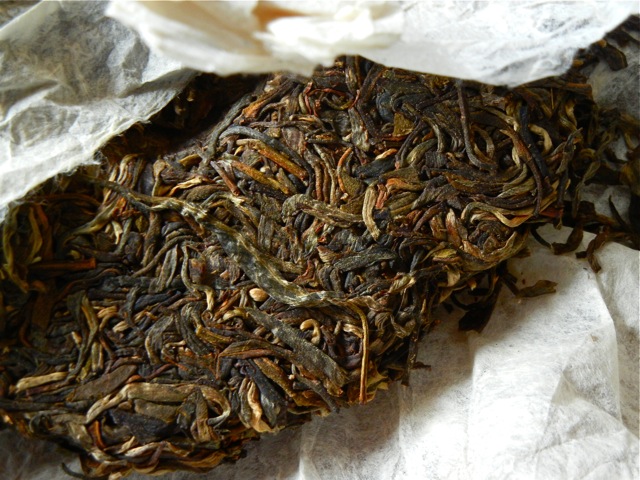

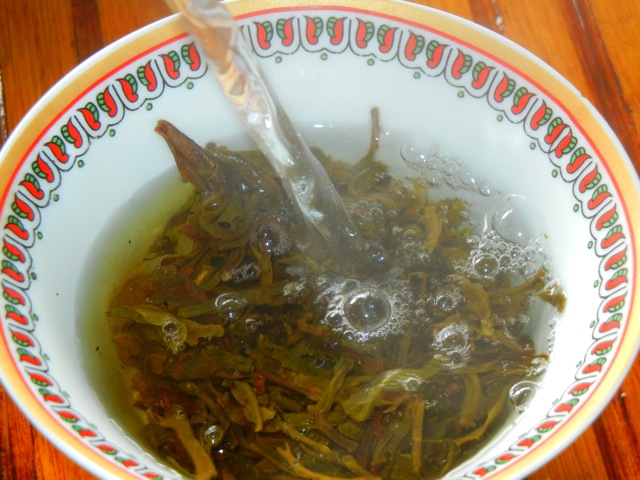
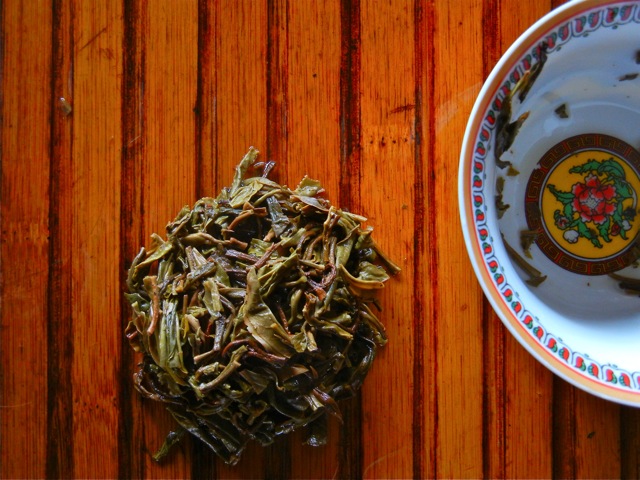
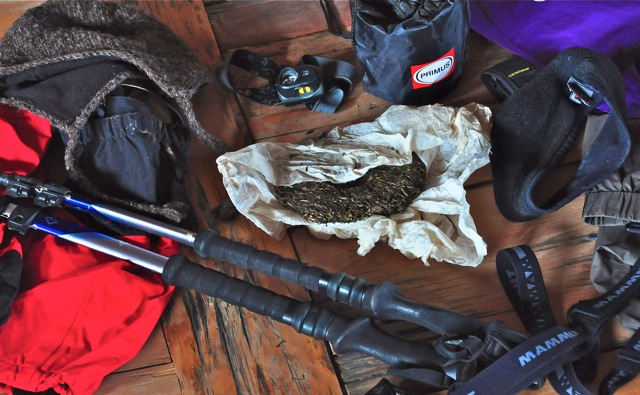
Humans have such a complex capacity to select this over that. It is a pleasure to be taken on your journey through choice.
A pleasure having you join these journeys.
Jeff